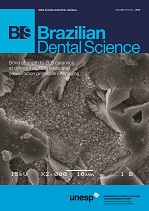Treatment Outcomes Based on Patient’s Oral Health Related Quality of Life (OHRQoL) after Receiving Conventional Clasp or Precision Attachment Removable Partial Dentures in Distal Extension Cases: A Randomized Controlled Clinical Trial
DOI:
https://doi.org/10.14295/bds.2019.v22i4.1819Abstract
Purpose: To compare the effect of two treatment options in mandibular Kennedy class I cases regarding oral health related quality of life (OHRQoL) and the biting force, removable partial dentures retained by either precision attachment (PA-RPD) or clasps (C-RPD)
Materials and methods: The study included 32 partially edentulous patients which 16 patients received PA-RPD (OT Cap Attachment) and 16 patients received C-RPD. All the patients in both groups were asked to fill the OHRQoL questionnaire after 1 week (baseline), 3 months, 6 months and 12 months after prosthesis insertion. Biting force was measured using the i-load Star Sensor one week, 3 months, 6 months and 1 year after partial denture insertion for all patients in both groups. Statistical analysis comprised Mann Whitney U test, Friedman’s test, Dunn’s test and Chi-square test.
Results: The results of OHRQoL revealed that at the baseline, 3 months and 6 months the PA-RPD showed statistically significant lower mean total OHIP-14 score than the C-RPD. However, after 12 Monthes , there was no statistically significant difference between total OHIP-14 scores in the two groups. Concerning the biting force there was no statistically significant difference between the two groups.
Conclusion: Within the limitations of this study it was concluded that the OHRQoL of both the PA-RPD and the C-RPD was comparable after 12 months. Similarly the biting force was the same for both treatment options.
Downloads
Downloads
Published
How to Cite
Issue
Section
License
Brazilian Dental Science uses the Creative Commons (CC-BY 4.0) license, thus preserving the integrity of articles in an open access environment. The journal allows the author to retain publishing rights without restrictions.
=================




























